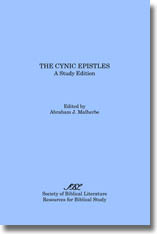SBL Press Bookstore

The Cynic Epistles: A Study Edition
Abraham J. Malherbe
ISBN
9780891301516
Volume
RBS 12
Status
Available
Price
$38.00
Publication Date
May 2006
$38.00
Edited by Abraham J. Malherbe; translated by Benjamin Fiore, S.J., Ronald F. Hock, Anne M. McGuire, Stanley K. Stowers, and David R. Worley
Long considered the definitive resource for study of the Cynic epistles, this work offers a collection of pseudepigraphic epistles attributed to various Cynic heroes and other figures revered by Cynics, including Anacharsis, Crates, Diogenes, Heraclitus, and Socrates. The collection includes the Greek texts, translations, a general introduction to the whole collection, and specific introductions to each group of letters. A bibliography, Greek index, and index of names are also included.
“The importance of Stoicism and Cynicism for the study of Christian origins has long been recognized. Johannes Weiss’s insistence that the student of the New Testament should know Seneca, Epictetus, Lucian, Musonius, and Marcus Aurelius intimately, and that the New Testament should be read with von Armin’s collection of Stoic texts at hand, reflected the general interest in the moral philosophers around the turn of the century. During that period the first work was done on those literary forms found in the New Testament which were thought to have been derived from Stoicism and Cynicism, viz. the diatribe, the Haustafel, the catalogues of virtues and vices, and interest was shown in the ideal philosopher as in some way a counterpart of the Christian apostle. It was primarily the Stoic sources cited by Weiss that were brought into the discussion, and contemporary scholars still largely depend on them for their understanding of what is Cynic and what is Stoic. Little awareness is shown of the differences, not only between Stoics and Cynics, but among Cynics themselves. It is ironic that scholars who are at pains to sketch in great detail the diversity of early Christianity should be content to be highly selective in the sources they use and to homogenize these sources when they delineate the cultural and religious context which they consider important for making that diversity intelligible. … Greater precision is required if we are to gain a realistic picture of the philosophical and religious context of early Christianity, and for that a better understanding of Cynicism in the early Empire is necessary.
A valuable but neglected source for the history of Cynicism is the Cynic letters. Most of these letters come from the Augustan age and purport to have been written by such ancient worthies of the sect as Antisthenes, Diogenes, and Crates and by such non-Cynics as Anacharsis, Heraclitus, Hippocrates, and Socrates and his followers, all of whom are represented as advancing Cynic views. The value of these letters lies in the fact that they are Cynic writings which provide evidence of Cynicism at the time when it was experiencing a reawakening. … The picture of Cynicism that emerges from the letters is of a rich diversity that compels us to be more circumspect in using the Stoic writers as authorities on Cynicism.”
Long considered the definitive resource for study of the Cynic epistles, this work offers a collection of pseudepigraphic epistles attributed to various Cynic heroes and other figures revered by Cynics, including Anacharsis, Crates, Diogenes, Heraclitus, and Socrates. The collection includes the Greek texts, translations, a general introduction to the whole collection, and specific introductions to each group of letters. A bibliography, Greek index, and index of names are also included.
From the Introduction
“The importance of Stoicism and Cynicism for the study of Christian origins has long been recognized. Johannes Weiss’s insistence that the student of the New Testament should know Seneca, Epictetus, Lucian, Musonius, and Marcus Aurelius intimately, and that the New Testament should be read with von Armin’s collection of Stoic texts at hand, reflected the general interest in the moral philosophers around the turn of the century. During that period the first work was done on those literary forms found in the New Testament which were thought to have been derived from Stoicism and Cynicism, viz. the diatribe, the Haustafel, the catalogues of virtues and vices, and interest was shown in the ideal philosopher as in some way a counterpart of the Christian apostle. It was primarily the Stoic sources cited by Weiss that were brought into the discussion, and contemporary scholars still largely depend on them for their understanding of what is Cynic and what is Stoic. Little awareness is shown of the differences, not only between Stoics and Cynics, but among Cynics themselves. It is ironic that scholars who are at pains to sketch in great detail the diversity of early Christianity should be content to be highly selective in the sources they use and to homogenize these sources when they delineate the cultural and religious context which they consider important for making that diversity intelligible. … Greater precision is required if we are to gain a realistic picture of the philosophical and religious context of early Christianity, and for that a better understanding of Cynicism in the early Empire is necessary.
A valuable but neglected source for the history of Cynicism is the Cynic letters. Most of these letters come from the Augustan age and purport to have been written by such ancient worthies of the sect as Antisthenes, Diogenes, and Crates and by such non-Cynics as Anacharsis, Heraclitus, Hippocrates, and Socrates and his followers, all of whom are represented as advancing Cynic views. The value of these letters lies in the fact that they are Cynic writings which provide evidence of Cynicism at the time when it was experiencing a reawakening. … The picture of Cynicism that emerges from the letters is of a rich diversity that compels us to be more circumspect in using the Stoic writers as authorities on Cynicism.”
